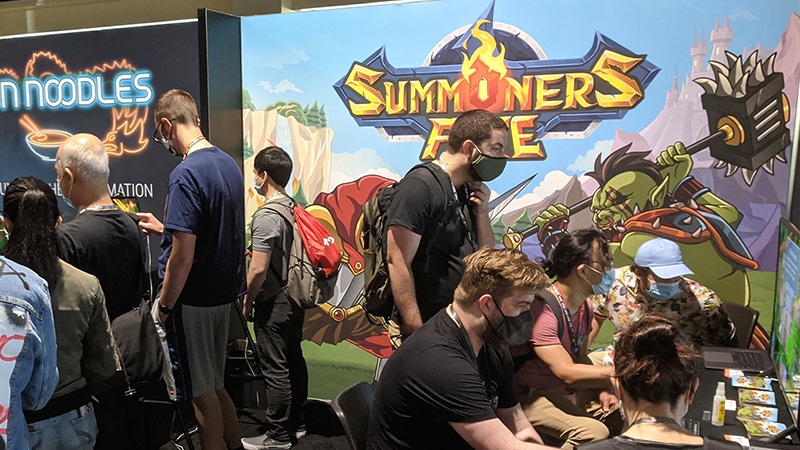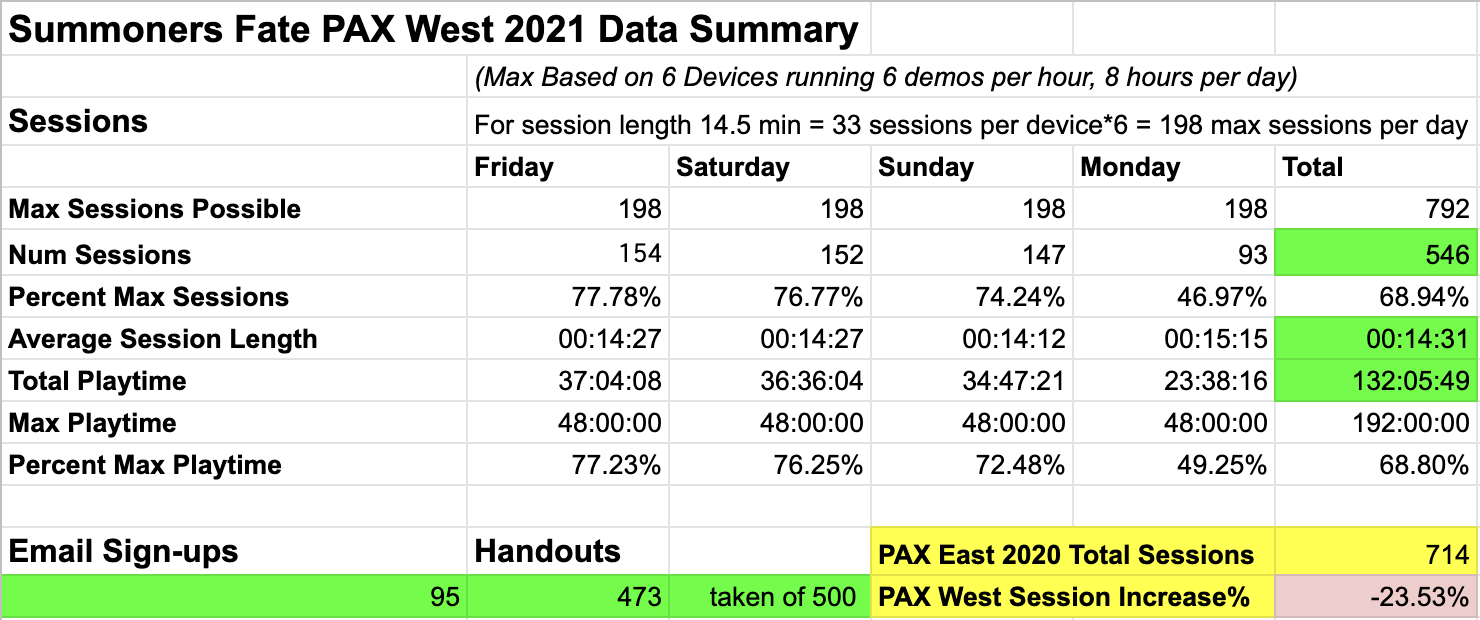
PAX West 2021 is the first major in person game convention since the Covid pandemic shutdown physical events in early 2020. Most of us anticipated attendance numbers would be smaller, but how did pandemic concerns actually impact developers who chose to showcase?
This year, we had the incredible honor of being selected for the PAX10, a curated selection of indie games chosen by PAX for a unique exhibitor experience. Read on to see how our showcase data compares to our 2020 PAX East exhibit.
What is PAX10?
PAX loves indie games, and each year, PAX West offers a unique opportunity for indie developers to showcase their games in a curated exhibit known as the PAX10. In order to participate, prospective developers must apply a few months in advance of the show by submitting their game and a supporting video to a panel of judges who review the entries and select 10 games to receive a complimentary booth space. That’s how it’s described on the website, but having gone through the experience - it’s so much more.
PAX astutely recognizes that indie games are an important part of the show for many attendees, and the games of PAX10 are celebrated as a feature attraction of the convention. The PAX team invests heavily in the PAX10, providing not only physical booth space, but prominent feature placement on their website and their Steam sale page. They also feature PAX10 games in their marketing materials - such as printing our game descriptions on the maps handed out to each attendee - a level of advertisement that would normally be out of the reach for the budget of small developers like myself.
This year, exceeding my wildest expectations, PAX went all out to provide what I like to describe as the “Rolls Royce” of indie booths. This included a 10’x10’ space, 6’ tabletop, 4K tv monitor, power (normally that’s extra, even for free booth standards), carpeting and a 10’x8’ printed art backdrop featuring our games’ keyart. The booths were placed in a prominent area of the show floor (right near major entrances) and also included additional carpeted space around the booths so as to allow the PAX Enforcers (volunteer staff) to create spacious queue lines for attendees waiting to play our demos.

PAX provided PAX10 exhibitors the “Rolls Royce” of indie booths, including a 10’x10’ carpeted area, power, 4K TV, 6’ table, 4 chairs, a massive 10’x8’ printed backdrop (which we got to take home), plus extra carpeted space in front of the booth. We set up 6 demo stations (4 iPads on tripods and 2 laptops).
In addition, PAX also purchased game keys from each of the developers to give away to attendees that visited the PAX10 and scanned their badges. They also held two panels for the PAX10 to discuss their games and interact with attendees. These were broadcast on their Twitch and their Steam sale page to thousands of concurrent online viewers.
I honestly can’t imagine a better showcase scenario for an indie developer, and I’m extremely grateful and honored to have been selected for this year’s showcase.
Our Budget
Along with the PAX10 booth, I am also very fortunate that my friend Chris lives in downtown Seattle, a short walk from the convention center. He generously hosted my stay with him and did everything a good friend can do to make me feel welcome and supported. This was, by-far, the most budget friendly showcase due to these key exceptions:
Booth Cost: $0
Airfare SLC to Seattle: $211.80
Marketing Hand-Outs (x500) and business cards (x500): $132.81
Food/Supplies: $134.47
PAX Key Giveaways: -$300
TOTAL: $179.08
The remainder total I made back in prerelease sales making this an ROI positive convention showcase (which is unheard of) - but we had a very lucky circumstance. Keep in mind that expos shouldn’t be budgeted for ROI - rather, you attend shows to build market exposure and interact with fans. These are intangibles that affect your success as a game developer, but can’t be attributed ROI. Think of the value of a billboard for Coca Cola (or any of their marketing). You can’t attribute sales to it, but it’s an integral part of building your brand that should be considered in your marketing strategy.
Our Data
PAX West 2021 is my 4th time showcasing at PAX, my 7th onsite convention for Summoners Fate, and my 9th major showcase (including digital events). I’ve written about our past experiences here on Game Developer, which you can find here.
Our exhibition demo is programmed with a custom telemetry system that tracks our session data so we can improve the game with each successive showcase. Combined with observation and asking players after their demo for feedback, we’ve learned a lot about how to build an effective game demo.
To provide context to this data before I present it, please note that I’ve only included sessions that lasted at least 60 seconds and where players initiated the first battle. Also note that this data only encompasses demo sessions. During the show, we offered a unique opportunity for players who had previously played our demo (at this PAX or at previous PAX) to play our full prerelease (including our multiplayer battles). Keep in mind this was a popular request (particularly on Monday when the show traffic was the lightest) and that this data is not represented here.
Here is our data summary:

Data Callouts:
We had 546 unique sessions with an average demo time of 14.5 minutes. This amounted to over 132 hours of playtime out of a maximum possible 192 hours for 6 demo stations (or 68.8% of our max possible showcase potential). That’s a phenomenal showcase rate.
At 546 sessions in PAX West 2021 compared to our 714 at PAX East 2020. The impact of Covid was a mere 23.5% decrease in booth traffic.
Friday, Saturday and Sunday were all heavily trafficked consistently with only Monday seeing a noticeable 40% decrease in traffic.
It's not quite an apples-to-apples comparison given our booth setup at PAX West was different from our PAX East Rising booth. But! Another interesting thing also happened with our funnel data:

We saw a 23% increase in our demo completion rate in PAX West 2021 over PAX East 2020 and an 88% increase in email registrations. I’m not entirely certain how much of this can be attributed to our PAX10 setup or improvements to the demo itself. We fine tuned controls and the open-world exploration system based on observations from our last showcase. Our demo also averaged a bit longer than PAX East (which was 11-12 minutes). For PAX West, we took our current Steam demo (average of 20-22 minutes) and shortened it for expo by eliminating a few battles, removing the lore feature (our story telling mechanism), and consolidating some of the tutorials so there would be less to read - bringing the demo time down to about 14-15 minutes.

We also saw increases in the battle win ratio. The largest increase (in level 2) can be attributed to a change we made to prevent players from having enough mana to cast Meteor Shower as a solution (effectively forcing them to choose the Gravity Blast) as well as adjusting the map so that Gravity Blast would defeat all the enemies more easily. One of our media reporters even called out level 2 as “brilliantly designed” for effectively teaching players the value of cards in gameplay without directly hand-holding them.

One reporter described our level 2 as “brilliantly designed” for effectively teaching the value of cards without directly hand-holding the player.
One reporter described our level 2 as “brilliantly designed” for effectively teaching the value of cards without directly hand-holding the player.
Key takeaways:
I had 6 demo stations (2 laptops and 4 iPads mounted on tripods). The demo takes an average of 14.5 minutes to complete, so the absolute maximum number of sessions we could have at the show if everyone played back-to-back (without delay) and completed the demo in average time would be 198 a day or 792 total. Most developers don’t consider their “max possible sessions” when planning their demos, so keep in mind that there is a physical maximum potential you can achieve in a 10’x10’ booth. Your showcase potential is limited by the number of demo stations - the more demo stations, the more demos, the more demos, the more fans who can fall in love with your game.
In my PAX East 2020 blog, I reported our average session length as 8:31. I had neglected to include the LicheBattle time, so the actual average was 11:50. Our PAX West 2021 demo was longer at 14:30. Initially, I advised shorter demos (to maximize number of sessions) - but perhaps longer demos (with more context provided) can positively impact conversion. Ideally, everyone who plays is invested enough to complete the demo. If your game isn’t the right fit for your player, it’s ideal they drop off immediately. Our highest drop-off point was after the first battle - but not because they couldn’t beat it (it had a 99.8% win ratio) - rather because they decided then and there that turn-based gameplay wasn’t for them.
Our Experience
To keep attendees safe and comply with Seattle’s health guidelines (at time of press), PAX required all exhibitors to be vaccinated and attendees show proof of vaccination and/or negative Covid results, as well as wear masks at all times indoors. My first step was to acquire a non-removable wrist band after providing the necessary documentation.

Me (Ross) waving after discovering our PAX10 booth upon arriving Thursday afternoon before the show.
Me (Ross) waving after discovering our PAX10 booth upon arriving Thursday afternoon before the show.
Walking into the expo hall for the first time Thursday afternoon was a shocking experience in contrast to years past. Normally, there would be crews from the AAA developers like Nintendo, Sony and Microsoft setting up their massive exhibits, but these were entirely absent this year. Even well known indie publishers I look forward to seeing each year like Behemoth and Devolver, did not attend. Instead, it was quiet, and brightly lit more like a banquet hall, with a handful of folks casually touring the floor. I could see end to end with the exception of the other section of the exhibit hall on the opposite side of the sky bridge. An


































